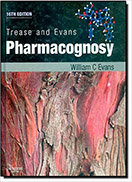Last edition Elsevier ‘Trease and Evans’ is an encyclopedic reference work on pharmacognosy — the study of those natural substances, principally plants, that find a use in medicine. Its popularity and longevity stem from the book’s balance between classical (crude and powdered drugs’ characterization and examination) and modern (phytochemistry and pharmacology) aspects of this branch of science, as well as the editor’s recognition in recent years of the growing importance of complementary medicines, including herbal, homeopathic and aromatherapy.
Last Edition
ISBN 13:h9780702029332
Imprint:hSaunders
Language:hEnglish
Authors:hWilliam Charles Evans
Pub Date:h05/2009
Pages:h616
Illus:h143 in full color
Weight:h2,090.00 grams
Size:h216 X 280 mm
Product Type:hHardcover
| List Price |
| grn 3934 |
| $ 128,99 |
| to order |
- • No other book provides such a wealth of detail.
- • A reservoir of knowledge in a field where there is a resurgence of interest - plants as a source of drugs are of growing interest both in complementary medicine fields and in the pharmaceutical industry in their search for new 'lead compounds'.
- • Dr Evans has been associated with the book for over 20 years and is a recognised authority in all parts of the world where pharmacognosy is studied, his knowledge and grasp of the subject matter is unique.
- • Meticulously referenced and kept up to date by the editor, new contributors brought in to cover new areas.
- • New chapter on 'Neuroceuticals'.
- • Addition of many new compounds recently added to British Pharmacopoeia as a result of European harmonisation.
- • Considers development in legal control and standardisation of plant materials previously regarded as 'herbal medicines'.
- • More on the study of safety and efficacy of Chinese and Asian drugs.
- • Quality control issues updated in line with latest guidelines (BP 2007).
- William Charles Evans, BPharm, BSc, PhD, DSc, FIBiol, FLS, FRPharmS, Formerly Reader in Phytochemistry, University of Nottingham, Nottingham, UK
- Part 1: IntroductionPlants in medicine: the origins of pharmacognosy
- he scope and practice of pharmacognosy
- Plant nomenclature and taxonomy
- Part 2: The plant and animal kingdoms as sources of drugs
- Biological and geographical sources of drugs
- A taxonomic approach to the study of medicinal plants and animal-derived drugs
- Pharmacological activities of natural products
- Synergy and other interactions in phytomedicines
- Traditional plant medicines as a source of new drugs
- Discovering new lead compounds in pharmaceutical research and development
- Part 3: Principles related to the commercial production, quality and standardization of natural products
- Commerce in crude drugs
- Production of crude drugs
- Plant growth regulators
- Plant cell and tissue culture; biological conversions; clonal propagation
- Phytochemical variation within a species
- Deterioration of stored drugs
- Quality control
- Part 4: Phytochemistry
- General methods associated with the phytochemical investigation of herbal products
- Basic metabolic pathways and the origin of secondary metabolites
- Part 5: Pharmacopoeial and related drugs of biological origin
- Introduction
- Hydrocarbons and derivatives
- Carbohydrates
- Phenols and phenolic glycosides
- Volatile oils and resins
- Saponins, cardioactive drugs and other steroids
- Miscellaneous isoprenoids
- Cyanogenetic glycosides, glucoinolate compounds and miscellaneous glycosides
- Alkaloids
- The search for naturally-derived anticancer agents
- Antiprotozoal natural products
- An overview of drugs with antihepatotoxic and oral hypoglycaemic activities
- Antibacterial and antiviral drugs
- Vitamins and hormones
- The plant nutraceuticals
- Colouring and flavouring agents
- Miscellaneous products
- Part 6: Plants in complementary and traditional systems of medicine
- Introduction
- Herbal medicine in Britain and Europe: regulation and practice
- Asian medicine
- Chinese herbs in the West
- Plants in African traditional medicine - some perspectives
- Part 7: Nonmedicinal toxic plants and pesticides
- Hallucinogenic, allergenic, teratogenic and other toxic plants
- Pesticides of natural origins
- Part 8: Morphological and microscopical examination of drugs
- Plant description, morphology and anatomy
- Cell differentiation and ergastic cell contents
- Techniques in microscopy
- Index
- To order a book, you need to send a phone number for a callback. Then specify:
- 1. Correct spelling of the first name, last name, as indicated in the passport or other document proving the identity. (Data is required upon receipt of the order)
- 2. City of delivery
- 3. Nova Poshta office number or desired delivery address.
- The prices on the site do not include the cost of Nova Poshta services.
- When prepaying for the Master Card, the supplier pays the order forwarding.
- Delivery is carried out anywhere in Ukraine.
- Delivery time 1-2 days, if the book is available and 3-4 weeks, if it is necessary to order from the publisher.




